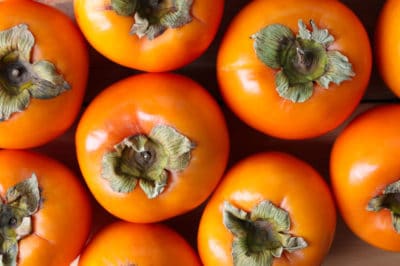Why Persimmon Fruit Bites Back
Unripe persimmon fruits fall into two categories: astringent and non-astringent. They all contain tannins, but astringent ones contain between five and 40 times the tannins of non-astringent ones.
How Tannins Act
When you bite into an unripe persimmon, its tannins bind with proteins in your saliva. Your salivary glands react by shutting off the flow to keep you from taking another bite. Persimmon tannins are related to the oak (Quercus spp.) tree tannins used to tan hides into leather. They’re hardly something that belongs in your mouth.
The Ripening Process
Over the course of the season, however, the fruit’s sugar content increases and its tannins slowly disappear. By the time an American persimmon is completely ripe, its pulp is nearly 34 percent fruit sugar.
Ripening produces other changes. Most noticeably, persimmon skin goes from green to brilliant shades of orange or red. As the compounds strengthening its cell walls break down, the pulp softens. When fully ripe, American and astringent Oriental persimmons feel like gelatin-filled balls.
Expert gardener’s tip: Non-astringent Oriental fruit also softens when ripe, but it’s marketed to eat while still firm and crisp.
Persimmon Picking Time
With persimmons, picking time and ripening time aren’t the same.
American persimmons ripen at different time on the same tree. Their extended ripening and picking period may last from mid-September to February. The trees (Diospyros virginiana) grow wild in USDA plant hardiness zones 4 through 9. Their ripe, neon-orange fruit usually drops to the ground where wildlife devours it.
Non-astringent Oriental persimmons (Diospyros kaki ‘Fuyu,’ USDA zones 8 through 10) are picked between mid-September and late November. They’re eaten when not quite ripe, with pumpkin-orange skin and crisp, mildly sweet pulp.
Astringent Oriental persimmons (Diospyros kaki ‘Hachiya,’ USDA zones 7 through 11) are picked between mid-September and late November. They ripen to tomato-red after being picked.
Expert gardener’s tip: Seal astringent Oriental persimmons with tomatoes in a plastic bag and store them at room temperature. The ethylene gas the tomatoes release will ripen the persimmons within two to four days.
